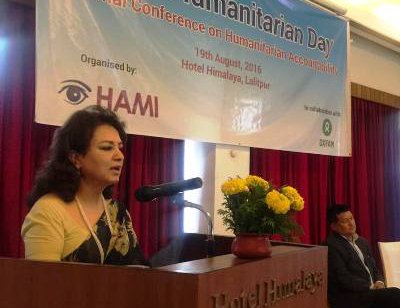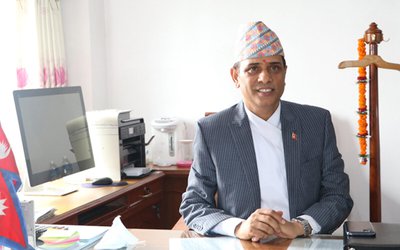
Even in eight years after the devastation by Koshi floods, Anil Kumar Kusiyat, 30, Sunsari district, and his family are yet to get over their bad days. Frustrated and angered, Kusiyat, whose land and house were washed out by Koshi, along with the property of thousands of other people, is still living in a temporary shelter.
The government, international development partners and humanitarian agencies, which came to them with relief and rescue materials eight years ago, have all gone, but the plight of flood victims remains the same. “Despite our suffering, we are left on our own. We have been living in hardship,” said Kusiyat.
Bal Bahadur Thapa, 30, a flood victim of Surkhet, has a similar story to tell. The floods washed out land, house and field of Thapa in 2014. “All the government and international humanitarian agencies poured into our areas soon after the floods. However, there is no one to support us in the process of reconstruction and rehabilitation.
Rita Shrestha, 28, victims of Jure landslides, from Sindhupalchowk, shares a similar story. “Many victims of landslides have been living in temporary shelters with no land for livelihood. Despite commitments, the government has not responded to us properly,” said Shrestha, whose house washed by the Jure floods and lanslides in June 2014. “Women are the worst victims.”
After waiting for almost one and a half years, the Gurkha earthquake, which destroyed the traditional Newari Town of Khokana, Shyam Maharjan, along with other residents of Khokana, have decided to forward a proposal to reconstruct the old town. “Since people are living in temporary shelters, they don’t know when they will move to their houses.”
Bimala Devi Yadav of Sunsari, who is a survivor of 2008 Koshi flood, after her fertile land turned into a river bank, says she cannot grow paddy anymore as her land got silted and unproductive.
Another flood victim of Surkhet Saha Bahadur Khadka, 68, who survived the 2014 floods, hanging on to the branches of a tree for two days, said he has been living in a temporary camp in Surkhet, with 7 family members, in the middle of a jungle, for two years.
Ram Kaji Shrestha, 72, and Ganesh Maya Shrestha, 63, of Barhabhise, Sindhupalchowk, survived three major disasters- landslides, earthquakes and floods in the span of two years.
They lost their only son in the earthquake last year and the Bhotekoshi flood this year swept away their land and their newly constructed house, which was built after the earthquake. They are now living in rented rooms and waiting for the government support.
Missing Support
At a time when government agencies and development partners have been claiming that they have been supporting the victims of disasters, these incidents expose the ground reality in which hundreds of victims have been left to fend for themselves.
At a national conference organized by HAMI and Oxfam on the World Humanitarian Day, participants discussed the state of victims of various disasters which destroyed houses and property of people.
“Disaster victims continue to face multiple challenges several years after disaster,” said a report prepared by HAMI and OXFAM. Experts, victims, right activists, government officials, media persons and members of civil society shared their views on the overall scenario of disasters and rehabilitation and reconstruction on World Humanitarian Day, which falls on 15 August.
According to a report, every year, about 500 people die in Nepal in different kinds of disasters. Floods, landslides, thunderbolts, and fires are among the major disasters Nepal faced in the last five years. Earthquakes of 2015 alone took lives of nearly 9000 people and injured more than 22,000 others.
According to a report, more than 300 people lost their lives in various districts of Nepal from Baisakh 1 to Shrawan 32 by disasters caused by floods, heavy rainfall, and landslide, and affected more than 10,000 families.
As Nepal is one of the disaster prone countries of the world, several disasters have hit the people and the survivors continue to suffer, often with their dream of a dignified life, moving far away. Oxfam in Nepal works in seven out of the 14 earthquake affected districts, providing short term as well as long term support to the people affected.
Event in a year and a half, victims of earthquake are yet to receive the relief materials. According to National Reconstruction Authority, it has handed over the first installments of relief for over 100,000.
With so many people left out, HAMI and OXFAM have shown interest to see how victims of the different disasters have been living and how much resources they received.
"Disasters inflict pain, trauma and unimaginable losses. The recovery and rehabilitation of the survivors must focus on short-term and long-term support so that they can get back to normalcy as early as possible," says Cecilia Keizer, Country Director of Oxfam in Nepal.
Oxfam has been working in Nepal for the last three decades. Since 2010, it started its Disaster Risk Reduction Program that helps people prepare for disasters like earthquake. Oxfam and its partners have established many stockpiling centers with items that will be required immediately after a large-scale disaster like earthquake
"Nepal must enact Disaster Management bill that protects the rights of disaster survivors and ensures proper recovery, reconstruction and rehabilitation," adds Ms Keizer.
Oxfam in Nepal works in seven out of the 14 earthquake affected districts providing short term as well as long term support to the people affected.
As a large number of victims are yet to receive the relief materials from the government agencies, the local government authorities are creating a lot of hurdles for the INGOs and NGOs as well. The chief district officer of Gorkha is personally busy in accusing the humanitarian agencies rather than facilitate them to carry out the post construction work effectively.
With no specific act in place for the disaster relief distribution, Chief District Officers are exploiting the loopholes and containing the activities of the civil society organizations. “The need of the hour is for the civil society and government agencies to work together,” said human rights activist Subodh Raj Pyakurel.
Disaster Bill
As there is a lack of a law to deal with the disasters holistically, the district administrations look at the issue as if it was a law and order and administrative issue and they undermine human rights and human perspectives.
“The disaster bill, pending with the government, should be enacted shortly and it is time to transform the existing National Reconstruction Authority as a mechanism to handle disasters overall,” said Sushil Gyawali, chief executive of the National Reconstruction Authority (NRA).
According to a report, Life After Devastation: Findings from the Ground launched by HAMI (Humanitarian Accountability Monitoring Initiative) and Oxfam in Nepal on World Humanitarian Day, large numbers of disaster victims are still suffering from trauma in the absence of post-disaster programs.
“Despite all claims, the victims are found to be living in temporary shelters where they have challenges in maintaining basic standards of life and many suffer from different illnesses,” said report. The report compiled the views of people affected by disasters as old as the Koshi Floods of 2008, Surkhet Flood of 2014, Jure Landslide and Earthquake.
Tens of thousands of survivors are still struggling to rebuild their houses destroyed by the April 25 earthquake of 2015 due to government’s delay in releasing aid.
The report Life After Devastation is a compilation of about a dozen case studies of flood, landslide, and earthquake survivors from nine districts—Banke, Bardiya, Dolakha, Nuwakot, Rasuwa, Sunsari, Saptari, Sindhupalchowk and Surkhet.
Since NRA, the body responsible for post-earthquake reconstruction, lacks mandate to rebuild villages destroyed by disasters like floods and landslides, people displaced in Koshi and Surkhet floods have been left homeless for years.
“The District Administration Office had identified 930 as flood victims in Surkhet. Of them, only 520 have received government announced relief while others are still awaiting government promised relief,” said Bal Bahadur Thapa, an earthquake victim of Surkhet flood.
Thapa informed that an elderly woman had already committed suicide returning to their respective houses destroyed by the flood with government’s negligence in releasing aid to 2014’s Surkhet flood victims.
Bandana Rana, an expert member at the United Nation’s Committee on the Elimination of Discrimination against Women, urged the government and non-governmental organizations to make Nepal’s post-disaster reconstruction process a success by incorporating maximum numbers of women in recovery process and addressing their priorities.
"In a few cases, it was found that children dropped out from school to share the burden to earn extra income for the family," says Min Bahadur Shahi, Convener of HAMI.
As Nepal was celebrating the World Humanitarian Day, the earthquake, flood and landslide victims attending the conference expressed the views that the government’s negligence in providing relief to the victims had left most of the victims in a serious crisis.

Keshab Poudel
Poudel is the editor of New Spotlight Magazine.
- CLA: Samriddhi For Skill Development
- Apr 23, 2024
- ECONOMY: Growth At 3.3
- Apr 16, 2024
- DPM’s SHRESTHA’S CHINA VISIT High Profile, Low Key
- Apr 14, 2024
- Maha Kumbha In Barahkshetra: A Sacred Festival In Sacred Koshi (Kaushiki) River
- Apr 09, 2024
- LOSS AND DAMAGE: Upper Tamakoshi A Case
- Apr 02, 2024
















